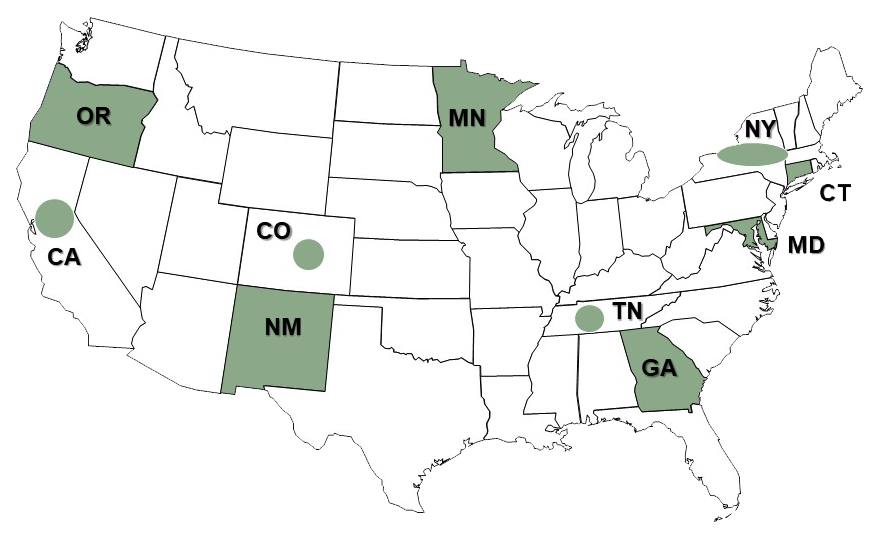What to know

Surveillance objectives
- To determine the incidence and epidemiologic characteristics of invasive disease due to group A Streptococcus (GAS), group B Streptococcus (GBS), Haemophilus influenzae, Neisseria meningitidis, and Streptococcus pneumoniae in multiple large diverse U.S. populations
- To determine molecular epidemiologic patterns and microbiologic characteristics of public health relevance for isolates causing the above invasive infections
- To provide an infrastructure for further research, such as special studies aimed at identifying risk factors for disease and post-licensure evaluation of vaccines
Surveillance areas and population
ABCs is a collaboration between CDC, state health departments, and universities participating in the Emerging Infections Program network. ABCs conducts surveillance across 10 states representing a population of approximately 45.9 million.
A case must meet the case definition to be considered for ABCs unless an exception applies.
Case definition
For CDC to consider a case for this surveillance system, the case must meet the following case definition:
- Group A Streptococcus, group B Streptococcus, Haemophilus influenzae, Neisseria meningitidis, or Streptococcus pneumoniae must be isolated from a normally sterile site, such as blood, cerebrospinal fluid, pleural fluid, peritoneal fluid, pericardial fluid, bone, joint/synovial fluid, or internal body site (e.g., lymph node, brain)
- OR ABCs pathogen-specific nucleic acid must be detected in a specimen obtained from a normally sterile body site, using a validated molecular test
- Case patient must be a resident of one of the defined surveillance areas
An exception to this sterile site case definition where CDC would count it as a case for this surveillance system:
- Group A Streptococcus isolated from a wound culture and accompanied by necrotizing fasciitis or streptococcal toxic shock syndrome
- Autopsy case in which a culture was taken ≤12 hours after death (handled on a case-by-case basis)
Case ascertainment
ABCs case finding is both active and laboratory-based. Isolation from a normally sterile site is essential to the case definition.
For case identification, ABCs personnel contact microbiology laboratories in acute care hospitals and reference laboratories processing specimens for surveillance area residents.
In hospitals without computerized microbiology data, surveillance personnel call designated microbiology laboratory contacts to identify new cases and request isolate submission. Where microbiology data are computerized, personnel obtain electronic line listings of all ABCs sterile site isolates.
Data collection methods
ABCs personnel complete a standardized case report form on all identified cases. Additional forms are available for early- and late-onset GBS disease, neonatal sepsis, and invasive pneumococcal disease in children and older adults.
Laboratory Characterization
CDC performs laboratory characterization on collected bacterial isolates as part of ABCs.
Surveillance Evaluation
Routine clinical laboratory audits
ABCs requires routine audits of the reporting clinical laboratories to ensure the system captures all cases of disease under surveillance.
ABCs requires an audit of all clinical laboratories at least once a year. Reporting site staff should review the primary data source for all organisms under surveillance compared to the list of reported cases. Data sources include laboratory log slips/log book and computer-generated electronic printouts.
Site surveillance methodology evaluation
In addition to the annual audit, each site performs an evaluation of their overall surveillance methodologies every 2 to 3 years. This ensures they are capturing all cases of invasive disease in catchment area residents for each pathogen under surveillance.
This evaluation includes identifying
- Laboratories located both within and outside of the ABCs catchment area that process specimens from residents of an ABCs site
- Facilities or state and local health departments that serve residents of the catchment area
Sites communicate with each laboratory, facility, or health department that contributes to ABCs cases to ensure continuous active- and population-based surveillance.
CDC surveillance indicators
ABCs assesses the following surveillance indicators:
- Percentage of isolates collected and sent to CDC
- Percentage of cases enrolled in special studies nested within the surveillance system
- Timeliness of scheduled isolate shipments
- Timeliness and sensitivities of completed audit data
ABCs evaluates the timeliness and completeness of reporting using threshold percentages of isolate collection and enrollment into special studies.
ABCs assesses surveillance "fatigue" or operational problems. ABCs captures this using isolate shipping schedules and audit sensitivities, and by ensuring the audit data are completed by set deadlines.
